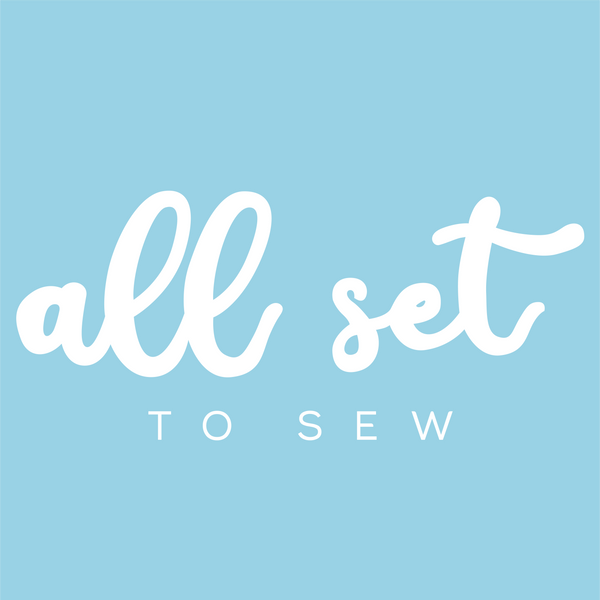Fat Quarter Club Subscription: Applique Clutch Bag
March 2023
This month’s kit from the Fat Quarter Club by Little Miss Sew ‘n’ Sew had me venturing into applique – a technique I hadn’t tried before now. It’s something I’ve actively avoided out of fear of getting it wrong. However, the instructions and easy-to-follow steps in the March subscription box had me sailing through this make. That’s just one of the great things about these kits; they get you trying something new and feeling like a pro in no time. Read on for a summary of this month’s make and some tips and tricks to help along the way.
In the box
Perfectly packaged and wrapped up like a present each month, the subscription boxes always feel like a treat when they hit the doormat. The kits contain all notions and fabric you need to make one clutch bag, and it’s rare that you use all the fabric included when completing the monthly make. Quite often you’ll be left with an untouched fat quarter to add to your stash – who doesn’t love that? Here’s what’s included in the march subscription box:
- 3x fat quarters from the ‘Spring Flowers’ collection by Lewis and Irene
- 25cm zip (the one included was a concealed zip, but I swapped this out for a standard zip for my make)
- Length of fusible fleece to make 1 clutch bag
- Medium weight interfacing for the inside pocket piece
- Fusible webbing for affixing the applique pieces onto the bag
- 25mm twill tape and a 25mm swivel clip for the key clip
- Applique clutch bag pattern sheet and instructions designed exclusively for Little Miss Sew ‘n’ Sew by Sew Cosy Patterns
- A sweet treat

Tools for success
The monthly subscription box contains all the materials you’ll need, but it doesn’t include the tools (especially because it’s hard to get a sewing machine through a letterbox), so here are a few things you’ll want to have to hand before you start:
- Scissors or rotary cutter – don't forget to have some regular kitchen scissors spare too for cutting the paper pattern
- Pins – to help fabric pieces stay together as you sew and to attach the paper pattern pieces to the fabric before you cut
- Cotton thread – I used a contrasting pinky-purple so the topstitching on the applique piece stood out
- Corner and edge shaper, or a knitting needle– useful when pushing out the corners of your pocket piece
- Zipper foot – I don’t have a concealed zipper foot for my rather basic machine, so I swapped out the zip included in the kit for a standard one (see pic). If you’re happy with applying concealed zips, and know your way around one with your machine, then you’re onto a winner (and braver than I am)

Tips and tricks to perfect your make
Having sewn make-up bags before, and the clutch bag not looking too dissimilar, I perhaps wasn’t as eagled-eyed when reading the instructions. Because of that, I made a bit of extra work for myself at the start when cutting out and prepping my material. Luckily, I enjoy the cutting out part of a make so it didn’t bother me – it just meant I had more time to sit and watch Netflix whilst I cut and prepped.
However, if you’re keen to save on time, or you stumble over some of the instructions, then here are some quick tips that might help you out:
- Read twice, cut once – I ended up tracing the applique pattern pieces onto tracing paper and then cutting out the individual fabric pieces and the individual fusible webbing. There’s a quicker and more straightforward way to prep your applique pieces on step 1 of the instructions. Given them a proper read! The result still looked great and it was dead easy to attach the applique pieces using the fusible webbing.

- Rights vs wrong – if this is your first foray into zips then a key step when applying them to something with a lining is making sure you have the fabric pieces the correct way up (or down) before you sew. Make sure you sandwich your zip in between your fabric with the right sides of each fabric piece facing each other and you won’t go wrong. The picture below shows the zip being added to the applique side of the bag and the front lining piece.

- Be generous – when sewing the lining pieces together (to create the inside of the bag), and sewing together the outer pieces of the bag, you’ll need to leave a gap that’s unsewn – this is on your lining pieces only. It’s crucial you leave the gao so you can pull the work inside out which will magically conceal your seams inside. I left a gap of around 8-10cm as I’ve made the mistake of being less generous in the past and struggling to then turn the work out. The bag is constructed using a decent amount of sturdy wadding and fusible webbing which helps to give the bag it’s shape and structure. That does mean it’s a little bulky when turning out, so don’t be too stingy.
Stitched up – the verdict
I enjoyed this make and was delighted with how simple I found applique thanks to the easy instructions. If you haven’t used fusible fleece, webbing or interfacing before then the kits from the Fat Quarter Club are a perfect way to try out different notions and build your confidence with guidance as you go – that includes zips too! Another delightful little make and the spring-themed fabric certainly brightened up my day. The fabric included in the kits is always curated for the time of year and relevant season. With the sun now shining, colourful flowers starting to appear, and beer gardens starting to call, this month’s spring clutch bag felt perfectly timed!


